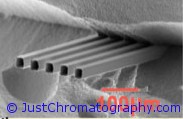Proteomics made faster
Posted in Lab on a Chip on May 18, 2007
The large-scale studies of structure and function of proteins (proteomics) are performed using a variety of analytical techniques from two-dimensional gel electrophoresis, immunoaffinity chromatography to tandem and MALDI-TOF mass spectrometry. The words “large-scale” in proteomics definition refers to the fact that the number of proteins that need to be evaluated is enormous. For example, the human body may contain more than 2 million proteins, each having different functions, and that’s why there is a great pressure from proteomics research to increase the throughput of protein analysis and that’s where lab on a chip technology comes into play. But so far we only have a handful of analytical processes that have been 100% transferred onto a chip, and most of what is being used now is a hybrid system.
 Integration of a conventional electrospray mass spectrometer with a chip-based analysis system has long been a problem. Polymer-based systems have been tried but they tend to have a high affinity for proteins and are incompatible with some organic solvents, leading to microfluidic flow problems as well as nozzle-clogging. But Daojing Wang and colleagues at Berkeley National Laboratory developed a new device that interfaces lab-on-a-chip technology with a conventional mass spectrometer and is easily microfabricated via silicon lithography.
Integration of a conventional electrospray mass spectrometer with a chip-based analysis system has long been a problem. Polymer-based systems have been tried but they tend to have a high affinity for proteins and are incompatible with some organic solvents, leading to microfluidic flow problems as well as nozzle-clogging. But Daojing Wang and colleagues at Berkeley National Laboratory developed a new device that interfaces lab-on-a-chip technology with a conventional mass spectrometer and is easily microfabricated via silicon lithography.
The team’s solution was to use a novel silicon microfabrication process that can mass-produce multinozzle emitters from silicon wafers. This allowed the dimensions and number of free-standing nozzles to be systematically and precisely controlled during the manufacturing process. Once integrated with a mass spectrometer, multinozzle emitters achieved sensitivity and stability in peptide and protein detection comparable to those of commercial silica-based capillary nanoelectrospray tips.
Reference: “Microfabricated Monolithic Multinozzle Emitters for Nanoelectrospray Mass Spectrometry”
by Daojing Wang and et al, Anal. Chem., DOI: 10.1021/ac070010j
Tag Cloud
-
adsorbent
benzene
china
chlorophyll
chromatographic
chromatography
column chromatography
CZE
DESI
electromagnetic induction
electrospray
ELISA
eluent
explosives
forensic
furosine
Gas Chromatography
GC/MS
History
HPLC
IC
isoflavones
lab-on-a-chip
LCMS
maldi tof
Mass Spectrometry
microfluidic
nano
Nano HPLC
nanoliquid
nanoscale
nanostream
nanotechnology
nanotubes
News
organic molecule
protein
Rickettsia
rmsf
rocky mountain spotted fever
science
soy
TCM
ticks
tsvet


